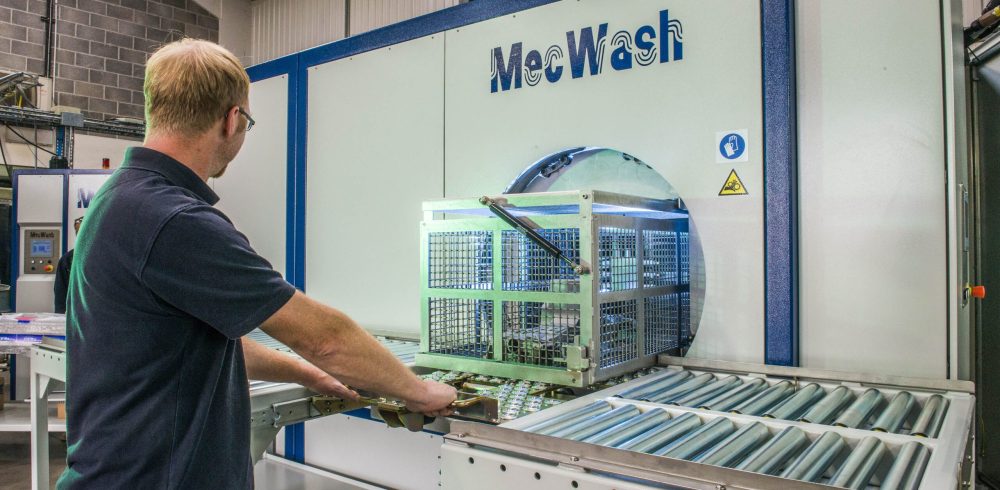Ultrasonics are widely used for cleaning anything from jewellery to electronics and are used for a very wide range of engineering components. But what are ultrasonics and when should they be used as part of your cleaning regime?
Ultrasonic cleaning works by the transmission of high-frequency sound waves through the wash solution. The sound compression waves cause cavitation, microscopic bubbles in the cleaning solution, which implode on the component surface generating an intense scrubbing action. being cleaned.
For most industrial applications, ultrasonics are not the first choice, as they can require a relatively long wash cycle time compared to spray or immersion systems and they can be expensive.
However, there are several applications where ultrasonics can be very valuable, typically:
- Tenacious contamination
- Intricate shapes with small apertures
- Removing fine contamination, to achieve high cleanliness specifications.
Some tenacious contamination can be blasted off with sprays or harsh chemistry (e.g. many greases), but others tend to cling on and need a more subtle approach, e.g. some polishing compounds and NDT solutions.
Complex shapes can also benefit from ultrasonics, when the geometry reduces solution flow over the surface – e.g. fine blind holes, plates close together, fine matrix structures. The geometries mask themselves such the energy from flowing solution is reduced and the ultrasonics compensates.
Finally, particles tend to be more strongly attracted to a substrate, the smaller they are. So, for very small particles, large, localised cleaning energy is very helpful. Ultrasonics can provide this energy which is why ultrasonics are so popular for applications with stringent cleanliness specifications.
Having identified ultrasonics as a useful part of your cleaning process, you then need to decide what frequency. 25 khz is the most common frequency used in industrial applications, and the most powerful commonly available (the lower frequencies create bigger bubbles with a bigger bang on implosion). However, if you are targeting smaller particles, you need to adopt higher frequencies. 40 kHz is also quite popular for engineering applications needing high cleanliness standards. More exacting applications, such as cleaning silicon wafers, may opt for very high megasonic frequencies.
Although ultrasonics are very useful for these applications, in general they form only part of the process. In most engineering applications you will have a mix of contamination, oils or coolants, metal swarf and dust, packing materials etc. As such the most efficient cleaning process can comprise a mix of techniques, spray, immersion and ultrasonics with careful chemical selection.
Combining all these potential process elements into one cleaning system that delivers consistently high standards while processing industrial volumes and keeping process fluids in condition is a real challenge.
John Pattison, managing director at MecWash Systems Ltd, who specialise in building high performance industrial aqueous cleaning systems, comments:
“Many people think of a line of dunk tanks when they think of ultrasonics. Although this may work for some low volume or scientific applications, it is rarely ideal for an engineering operation. Such static systems only really work when parts are pretty clean to start with, as there is very little solution movement over the parts and the systems often have limited ability to maintain themselves (e.g. removing swarf or oil from the process chamber) so you can’t run them 24/7 without repeated maintenance.
“At MecWash we specialise in high specification cleaning for engineering businesses, in high precision sectors, hydraulics, aerospace, automotive, precision engineering and medical. We integrate ultrasonics into our systems so you can have spray, immersion and ultrasonic wash and rinse processing, plus hot air and vacuum drying using one process chamber, giving an integrated process in a compact machine. Like all our systems these are designed for 24/7 use and can manage the solutions through filtration, oil separation and coolant removal.
“Our MWX systems hold four ultrasonic rod transducers, which can be single or mixed frequency (so you can run both 25kHz and 40kHz), depending on the contamination targeted. With the MWX series, the basket rotation or oscillation eliminate dead spots and this gentle movement allows solution to continuously pass over the surface and contamination falls away. Our systems can provide up to 20 watts/litre in the MWX400 and 30 watts/litre in the MWX300 at 25kHz.
“Basically, we take the ultrasonic concept and make it work for the production environment. Building ultrasonics into one of our trusted, robust systems, that are used by blue chip engineering businesses around the globe. MecWash customers from automotive, aerospace, fluid power, precision engineering and medical industries are becoming increasingly insistent on the addition of ultrasonics to their bespoke machines, and for good reason,” said John.
Manufacturing & Engineering Magazine | The Home of Manufacturing Industry News















